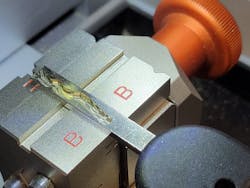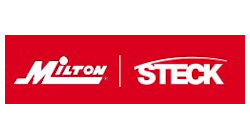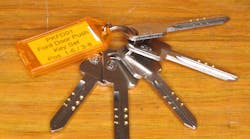Laser-cut keys, also known as sidewinder keys, high-security keys, worm-cut keys, etc. were introduced in the 1990s as an enhanced measure of physical security for automotive applications. Automotive thefts had been rampant throughout the 1980s and well into the following decade. Because microprocessing technology still was in its infancy for automotive security applications, the next-best thing was to modify or enhance physical-security measures, which were the edge-cut keys of that era.
In the 1990s, laser-cut keys were used in some premium vehicle makes and models as an optional feature. The goal behind the technology was to make automobile locks much more difficult to pick and significantly more difficult to duplicate. It worked.
Today, it’s extremely rare to find a vehicle that uses a laser-cut key but doesn’t employ a transponder system (looking at you Hyundai/Kia). It also is becoming increasingly rare to find even entry-level vehicles that don’t employ the use of a high-security key, the most glaring exception being Nissan, which skipped over traditional physical-security measures and jumped right into secure gateway modules.
The Key Components
Unlike traditional edge-cut keys, laser keys are created by notching out a groove in a key blade that essentially is a solid plank of metal. The notch is carved out by what appears to be a tiny drill bit, unlike the cutting wheels that define standard edge-cut duplicators and code cutters. These same bits can handle edge-cut keys, although that process is typically a bit slower than traditional wheel-based edge-cutting.
There’s no impressioning by using a file to be had here. Even simple tricks, such as sight reading, are significantly more difficult when dealing with a laser-cut key. The inner workings of the reciprocal locks that are operated by these keys also are much more robust and complicated as a result, but that’s a topic for another time.
If you haven’t embraced laser key cutting, this would be for one of only two reasons. The first is that you do no automotive work whatsoever. Because laser-cut keys are a hallmark of the automotive world, none of this will be relevant to you, which is perfectly understandable.
The second reason is that you’re apprehensive about the complexity or the costs involved in retrofitting your operation with all of the parts and equipment necessary to service modern vehicles. It isn’t crazy that a modern automotive locksmith would be hesitant to invest in the complete ecosystem of high-security keys and cutters. I happen to know several automotive locksmiths who work only on edge-cut vehicles, and that absolutely blows my mind.
The standard laser-cut transponder keys aren’t much more expensive than their edge-cut counterparts. For example, Honda’s final production of an edge-cut key, the HD106, is almost the same price as its most common laser-cut key, the HO03. The HO03 represents more than a decade of emerging automotive security technologies, and it costs only a few cents more than its direct predecessor.
Now, of course, this isn’t the norm, and there certainly are scenarios where a laser-cut key costs significantly more than its edge-cut predecessor, but this typically is because of the costs involved with producing the transponder chips contained inside.
Making the Cut
As for the cutters themselves, laser-cut technology is so tried and true that even the least expensive laser-cut code cutters have achieved a level of reliability that makes them suitable for commercial use. Much like the technological advancements made in the vehicles that these machines service, these key cutters have become technological marvels.
One example is the Condor XC Mini by XHorse. It’s fully automatic and computer-driven, to the point where the locksmith simply has to place an existing key in the appropriate jaw and, with the push of a button or two, could decode and duplicate the key from beginning to end with minimal intervention.
The machine is self-calibrating and includes Instacode’s complete code database, which is extremely useful for fill-progressioning. This process automatically makes educated guesses about any cuts you weren’t so confident about upon decoding the lock.
The current iteration of the Condor, the XC Mini Plus, now contains a proprietary code database and other bells and whistles. One thing missing from both versions, however, is the capability to cut nonautomotive keys by code.
Other laser key machines can cut nonautomotive residential or commercial keys by code. The Triton by Lock Labs, for example, can duplicate and generate most commercial, residential, institutional and automotive keys by code. It even makes quick work of dimple keys, such as those manufactured by Mul-T-Lock. The Triton features a proprietary code database that enables cutting by code for all by supported key types, so you don’t have to purchase any additional code-conversion software.
It includes an integrated fill-progressioning service that assists you in forecasting missing cut depths via the proprietary code database for when you attempt to decode and generate a key. This most certainly will help you to reduce time while in the field by eliminating guesswork during impressioning.
The Triton’s direct duplication feature traces and cuts unknown keyways for those rare instances when you have an original key and a compatible blank but no space and depth information. The advanced key-tracing feature also accounts for wear on known keyways and automatically rounds off measurements to meet the original key specifications, or it will cut to a precise match if that’s what you prefer. You also can create custom key profiles that will allow you to input your own space and depth information and tether it to the keyway of your choice.
Higher end options, such as Laser Key Products’ 3D Elite, the Futura series by Ilco and the Ninja series by Keyline, are other examples of key-cutting machines that are absolute laser-key workhorses and boast a number of proprietary features of their own.
Laser-key machines are relatively inexpensive, and the keys don’t cost much more than standard edge-cut automotive versions. So, given their widespread use, it makes sense to take this step.
As far as expanding your knowledge base, check out your local locksmith association’s course offerings and take an introductory automotive class. ALOA has some of the best instructors in the business. Ease into laser-key cutting by tinkering with automobiles at junkyards or by making duplicate keys for family and friends.
Mo Ali is vice president of product development for American Key Supply and has more than 20 years of experience as an automotive electrician and a locksmith.






